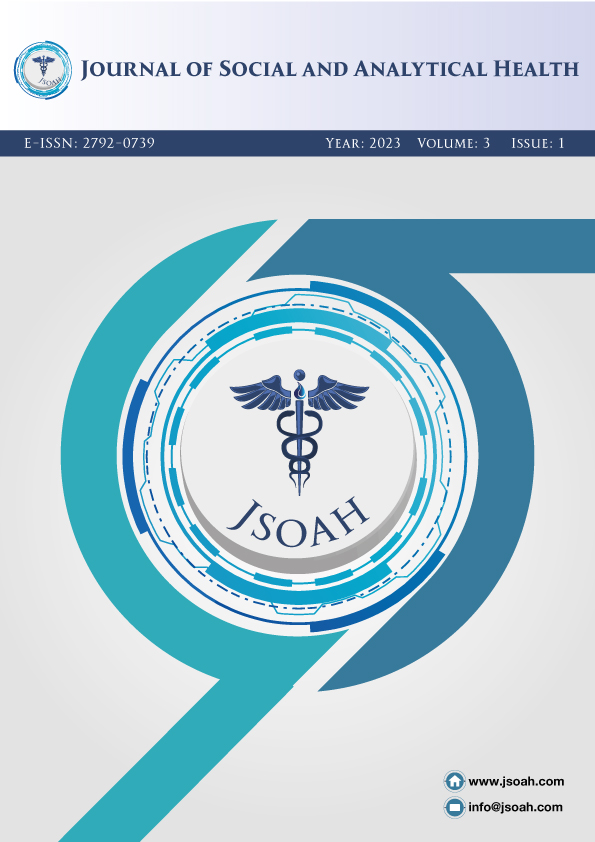Sağlık bölümlerinde okuyan öğrencilerde sağlık algısı, sağlık anksiyetesi ve etkileyen faktörlerin belirlenmesi
DOI:
https://doi.org/10.5281/zenodo.7509127Anahtar Kelimeler:
Anksiyete, sağlık kaygısı, sağlık algısı, öğrenciÖzet
Amaç: Bu çalışmanın amacı, sağlık bölümlerinde okuyan öğrencilerin sağlık algısı ve sağlık kaygısı düzeylerini ve bunları etkileyen faktörleri belirlemektir.
Gereç ve Yöntem: Araştırma verileri, Eylül-Ekim 2022 tarihleri arasında bir üniversitede öğrenim gören ön lisans öğrencilerinden toplanmıştır. Araştırmanın örneklemini Bingöl Üniversitesi Sağlık Hizmetlerinde okuyan 371 öğrenci oluşturmuştur. Araştırma verileri sosyo-demografik özellikleri içeren form, Sağlık Algısı Ölçeği ve Sağlık Anksiyetesi Ölçeği kullanılarak çevrimiçi olarak toplanmıştır. Verilerin analizinde SPSS programı kullanıldı. Veriler analiz edilirken sayı, yüzde yaş frekans dağılımları ve bağımsız t testi, kruskall-wallis varyans analizi ve spearman korelasyon analizi kullanılmıştır.
Bulgular: Bu çalışmada sağlık algısı ölçeğinden alınan toplam puan 51.42±7.20, sağlık anksiyetesi ölçeğinden alınan toplam puan 18.87±8.49'dur. Öğrencilerin Sağlık Algısı Ölçeği alt boyutları ile sosyodemografik özellikleri (yaş, cinsiyet, ikamet yeri) arasında istatistiksel olarak anlamlı fark bulunmuştur (p<0.05). Öğrencilerin Sağlık Anksiyetesi Ölçeği alt boyutları ile sosyodemografik özellikleri (cinsiyet, ikamet yeri) arasında istatistiksel olarak anlamlı fark bulunmuştur (p<0.05).
Sonuç: Öğrencilerin sağlık algılarının ve sağlıkla ilgili kaygılarının orta düzeyde olduğu belirlendi. Öğrencilerin sağlık alanındaki tutum ve davranışlarını olumlu yönde değiştirmek için eğitimler ve sosyal etkinlikler düzenlenebilir. Problem çözme becerileri geliştirilebilir.
Referanslar
Aksüt AG, Soysal N, Balcı UG, Öngel K. Farklı hasta gruplarındaki tedavi sürecinde yaşam kalitesinin değerlendirilmesi. Ege Klinikleri Tıp Dergisi. 2018;56(3):109-113.
Elçin E, Khorshtd L. İki̇ farkli bölüm öğrenci̇leri̇ni̇n sağlik algilarinin karşilaştirilmasi. EGEHFD. 2016;32(2):1–10.
Açiksöz S, Uzun Ş, Arslan F. Hemşirelik öǧrencilerinin saǧlik algisi ile saǧliǧi geliştirme davranişlari arasindaki ilişkinin incelenmesi. Gulhane Med J. 2013;55(3):181–187. https://doi.org/10.5455/gulhane.15228
Şahin M. Korku, kaygı ve kaygı (anksiyete) bozuklukları. ASEAD. 2019;6(10):117-135.
Bahadir E. Sağlıkla İlgili fakültelerde eğitime başlayan öğrencilerin psikolojik sağlamlık düzeyleri. [Yüksek Lisans Tezi]. Ankara: Hacettepe Üniversitesi; 2009.
Alkan SA, Özdelikara A, Boğa NM. Determination of nursıng students' health perception. Gumushane University Journal of Health Sciences. 2017;6(2):11–21.
Diamond JJ, Becker JA, Arenson CA, Chambers CV, Rosenthal MP. Development of a scale to measure adults’ perceptions of health: preliminary findings. Journal of Community Psychology. 2007;35(5):557-561. doi: 10.1002/jcop.20164
Kadıoǧlu H, Yildiz A. Validity and reliability of Turkish version of perception of health scale. Turkiye Klinikleri J Med Sci. 2012;32(1):47–53. https://doi.org/10.5336/medsci.2010-21761
Salkovskis PM, Rimes KA, Warwick HMC, Clark DM. The health anxiety Inventory: development and validation of scales for the measurement of health anxiety and hypochondriasis. Psychol Med. 2002;32(5):843-853. doi: 10.1017/s0033291702005822.
Aydemir Ö, Kirpinar I, Sati T, Uykur B, Cengisiz C. Sağlık anksiyetesi ölçeği’nin Türkçe için güvenilirlik ve geçerlilik çalışması. Noropsikiyatri Arsivi. 2013;50(4):325–331. https://doi.org/10.4274/npa.y6383
Baumgartner JN, Schneider TR. A randomized controlled trial of mindfulness-based stress reduction on academic resilience and performance in college students. Journal of American College Health 2021;16(1):1–10. https://doi.org/10.1080/07448481.2021.1950728
Anshel MH, Smith M. The Role of religious leaders in promoting healthy habits in religious ınstitutions. JORH. 2014;53(4):1046–1059. https://doi.org/10.1007/s10943-013-9702-5
Tunc GC, Bilgin NC, Cerit, B. The relationship between international students’ health perceptions and their healthy lifestyle behaviors. JORH. 2021;60:4331–4344. https://doi.org/10.1007/s10943-021-01336-0
Park DY. The effects of family function, health perception, and self-efficacy on health promoting behaviors of nursing college students. J Korea Contents Assoc. 2017;17(6):561–70. https://doi.org/10.5392/JKCA.2017.17.06.561
Aksoy T, Uçar H. Hemşirelik öğrencilerinin sağlıklı yaşam biçimi davranışları. HUHEMFAD. 2014;1(2):53-67.
Çilingir D, Aydın A. Department of nursing students’ perception of health. Florence Nightingale Hemşirelik Dergisi. 2017;25(3):167–176. https://doi.org/10.17672/fnjn.343254
Ortabag T, Ozdemir S, Bakir B, Tosun, N. Health promotion and risk behaviors among adolescents in Turkey. JOSN. 2011;27(4):304–315. https://doi.org/10.1177/1059840511408322
Yiğital G. Sağlığın geliştirilmesi dersinin hemşirelik öğrencilerinin sağlıklı yaşam biçimi davranışlarına etkisi. Gümüşhane Üniversitesi Sağlık Bilimleri Dergisi. 2022;11(1):271-278.
Musavian AS, Pasha A, Rahebi SM, Roushan ZA, Ghanbari A. Health promoting behaviors among adolescents: a cross-sectional study. In Nurs Midwifery Stud. 2014;3(1):e14560. doi: 10.17795/nmsjournal14560.
Bobevski I, Clarke DM, Meadows G. Health anxiety and its relationship to disability and service use: Findings from a large epidemiological survey. Psychosomatic Medicine. 2016;78(1);13–25. https://doi.org/10.1097/PSY.0000000000000252
Chiu CJ, Hu JC, Lo YH, Chang EY. Health promotion and disease prevention interventions for the elderly: A scoping review from 2015–2019. IJERPH. 2020;17(15):1–11. https://doi.org/10.3390/IJERPH17155335
Huang Y, Zhao N. Generalized anxiety disorder, depressive symptoms and sleep quality during COVID-19 outbreak in China: a web-based cross-sectional survey. Psychiatry Research. 2020;288:112954. https://doi.org/10.1016/J.PSYCHRES.2020.112954
Aziz KA, Al-sanadi A, Al-shamsi A, Al-sharqi H, Al-zaabi M, Al-shehhi N. Health anxiety in medical students in the united arab emirates. Royal College of Psychiatrists International Congress. June 2018; Birmingham, United Kingdom. https://doi.org/10.13140/RG.2.2.25302.55365
Chen Q, Zhang Y, Zhuang D, Mao X, Mi G, Wang D. Health anxiety in medical employees: A multicentre study. Journal of International Medical Research. 2019;47(10):4854–4861. https://doi.org/10.1177/0300060519872310
Kızılkurt OK, Yılmaz A, Noyan CO, Dilbaz N. Health anxiety during the early phases of COVID-19 pandemic in Turkey and its relationship with postpandemic attitudes, hopelessness, and psychological resilience. PPC. 2021;57(1):399–407. https://doi.org/10.1111/ppc.12646
Arslan B, Özçelik S. Tıp fakültesi öğrencilerinde sağlık anksiyetesi ve hipokondri. Tıp Eğitimini Geliştirme Derneği Kongresi (TEGED). 2020; İstanbul, Türkiye.
Zahid MF, Haque A, Aslam M, Aleem NA, Hussain S, Fahad H. Health-related anxiety and hypochondriacal concerns in medical students: a cross-sectional study from Pakistan. Teach Learn Med. 2016;28(3):252-259. doi: 10.1080/10401334.2016.1155459.
Mohebi S, Parham M, Sharifirad G, Gharlipour Z, Mohammadbeigi A, Rajati F. Relationship between perceived social support and self-care behaviorin type 2 diabetics: A cross-sectional study. J Educ Health Promot. 2018;3(7):48. doi: 10.4103/jehp.jehp_73_17.
Ahn YC, Park HS, Ra GW. Perceived health status and health promoting behaviors among unıversity student. J Korean Med. 2014;32(4):52-64. https://doi.org/10.13048/jkm.14043
Hosseini M, Ashktorab T, Hosseintaghdisi M, Vardanjani AE, Rafiei H. Health-promoting behaviors and their association with certain demographic characteristics of nursing students of Tehran city in 2013. Global Journal of Health Science. 2014;7(2):264-272. https://doi.org/10.5539/gjhs.v7n2p264
İndir
Yayınlanmış
Nasıl Atıf Yapılır
Sayı
Bölüm
Lisans
Telif Hakkı (c) 2022 Journal of Social and Analytical Health

Bu çalışma Creative Commons Attribution-NonCommercial 4.0 International License ile lisanslanmıştır.


